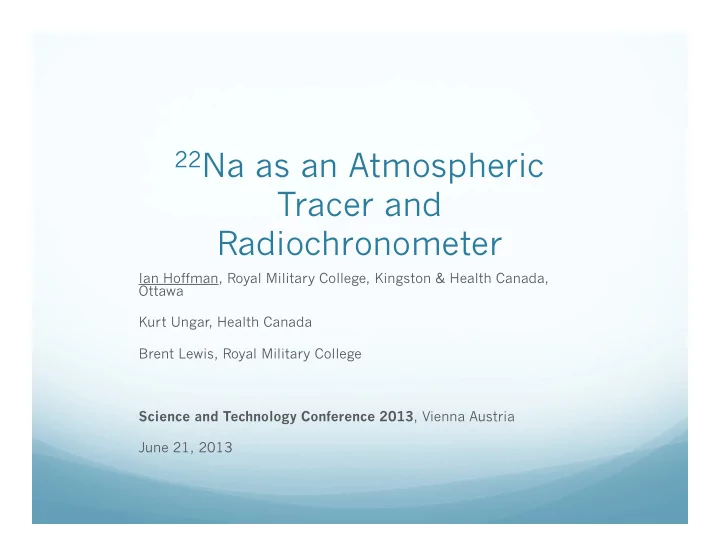

22 Na as an Atmospheric Tracer and Radiochronometer Ian Hoffman, Royal Military College, Kingston & Health Canada, Ottawa Kurt Ungar, Health Canada Brent Lewis, Royal Military College Science and Technology Conference 2013 , Vienna Austria June 21, 2013
Acknowledgements Harry Toivonen, STUK (Radiation and Nuclear Safety Authority, Finland) – Provided JMUFI software for use Andreas Pelikan – author of JMUFI software
Contents 1. Background 2. Goals 3. Theory and Method a. Procedural Flowchart b. Components c. Spectroscopic Analysis 4. Preliminary Results 5. Future Work
Background Radionuclides have long been used as environmental tracers allowing examination of many physical phenomena 14 C, U/Pb, 40 K/ 40 Ar, 147 Sm/ 143 Nd, 10 Be Measurements allow: Water or airborne transport pathway analysis Stratospheric-Tropospheric Exchange (STE), bulk air mass transport Water flows and residence times Age of materials ice cores, sediments, bones, artifacts, etc. Provided: Initial conditions and any contamination effects are known Historical cosmic ray flux is important for cosmogenics
Background Two factors influence the production of cosmogenic radionuclides Cosmic ray intensity Geomagnetic shielding 7 Be is a commonly studied cosmogenic isotope produced through spallation of isotopes of N, O, C and Ar High production rates and easy to measure at ground level 22 Na is also cosmogenic but principally produced by spallation of 40 Ar Ar is rare (.9%) in the atmosphere 22 Na is produced at about 1/1000 the rate of 7 Be Difficult to measure – only under specific circumstances Can 22 Na be used as an atmospheric tracer?
Background For environmental aerosols considerable knowledge has been obtained. Consider 7 Be (from [1]): Year Anti-correlated with 1972 1976 1980 1984 1989 1993 1997 2001 200 sunspot number and correlated with cosmic ray 150 Sunspot number intensity 100 22 Na expected to behave 50 21 22 23 similarly as production process is similar 4000 7 Be [ µ Bq/m 3 ] 22 Na has not been studied 3000 very much due to lack of 2000 data 1000 The atmosphere plays a Cosmic ray intensity strong role in observed [Counts/hour]/100 4000 concentrations 3600 3200 2800 1972 1976 1980 1984 1989 1993 1997 2001 Year
Background The atmosphere has 3 major transport circulation cells and 5 major layers The bottom two layers (troposphere and stratosphere) are the active regions Production is principally in stratosphere with a small amount in upper troposphere.
Goals This work was an attempt to: Provide the first global data set of 22 Na activity concentrations Corrected for coincidence summation (1 st time performed for 22 Na) Study the resulting statistical distributions of 22 Na activity concentrations and geographic influences (geomagnetic shielding) A spectral summation technique was applied to generate data. Artificially increase air sample volumes at a cost of temporal resolution
Theory and Method - Model Jasiulionis and Wershofen[2] modelled the behaviour of these nuclides vertically Predicts ground-level 22 Na concentrations between 0.2 - 1.1 μ Bq/m 3 7 22 Predicts ground-level 7 Be concentrations that match what is observed in the IMS (~ 1- 8 mBq/m 3 ) These low 22 Na activity concentration predictions are the reason special techniques are needed to measure this radionuclide
Theory and Method -Spectral Summation One approach is to perform spectral summation Channel-by-channel addition of raw MCA data over some time interval We can get a sense of spectral summation by stacking spectra and viewing them from the “top”
Theory and Method – Source Data The spectral data source are the raw files from the Comprehensive Nuclear-Test- Ban Treaty (CTBT) International Monitoring System (IMS) from 2005 - 2011. 80 particulate stations at completion well-distributed globally Over 80% operational currently, >50% during study period Daily high volume (> 20 000 m 3 ) aerosol collection MDC - 22 Na ~ 0.2 μ Bq/m 3 , 7 Be ~ 0.8 μ Bq/m 3 24 hour sample collection, 24 hour “cool-down”, 24 hour measurement
Recommend
More recommend